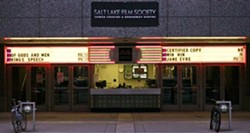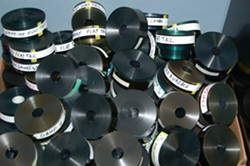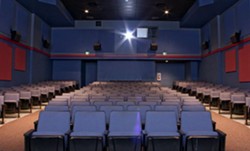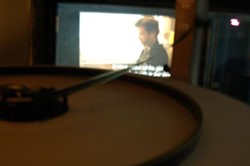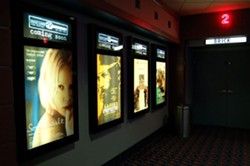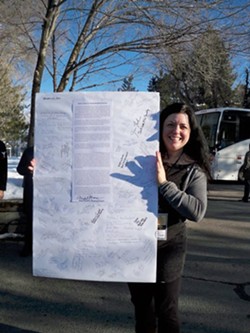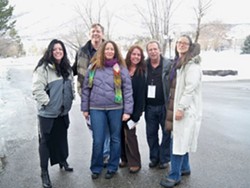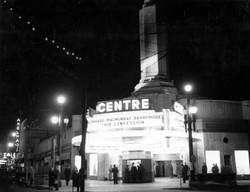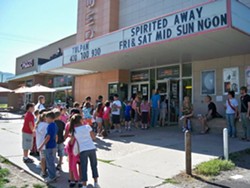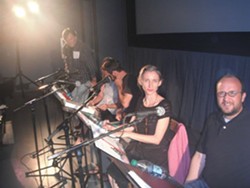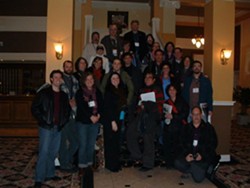Sunday, November 13, 2011
Salt Lake Film Society: Tori Baker
Posted By Gavin Sheehan on November 13, 2011, 11:59 PM
As you may have read over the last few months, the Salt Lake Film Society turned 10 this year and wasted little time celebrating. --- And with good cause, as the not-for-profit organization has lured in cinema viewers by the truckload with rare and exclusive films that never make the major multiplex theaters, as well as playing a part in bringing Sundance from the hills to the valley for those who don't wish to trek the highways.
Part of the organization’s success has come from the small crew and volunteer staff who have worked hard over the past few years to put everything together and keep the organization going. Today, we have an extra-long interview with executive director Tori Baker about her career prior to SLFS, changes and monumental moments during her time in charge, where the organization is headed next, thoughts on local filmmaking and many other topics as she looks ahead to the next 10 years.
Tori Baker
Gavin: Hey, Tori. First thing, tell us a little bit about yourself.
Tori: I'm about as local as you can imagine. I grew up in West Jordan and attended the U, my family is here, as well. Movies and the process of movie-making have always been of interest to me. I love working nonprfofit and for the community. Life balance is important to me. I have a four-year-old child, though, so it's more striving towards life-balance than actually achieving it. I love that Michelle Obama has brought more attention to the importance, challenges and rewards of family balance for the career woman. I love to felt, and in my free time (which isn't much) do miniatures of people's pets.
Gavin: How did you first take an interest in movies and filmmakiing, and what were some of your favorites growing up?
Tori: Movies are a part of my life. I grew up in that exciting time where there was a palpable teen genre emerging with John Hughes films, our imagination was filled with Stephen Spielberg and George Lucas films and we were terrified by what are now classics in the horror genres. I will never forget seeing Superman at the Redwood Drive-In so don't ask me about the "big one" hitting, because forever imprinted in my brain is the Earth swallowing Lois Lane during an earthquake. As far as favorite movies go, that one is always tough. Mostly because it can shift depending on my phase in life, mood, or what I've been focused on recently. Some of the steady films I love are: Chaplin films, particularly City Lights and Limelight, Apocalypse Now, and Giant is a movie that I can't get enough of, and if I sit down to watch it for five minutes I will still be sitting there three and a half hours later.
Tori: I'd count Evil Dead and Halloween among my favorites in the horror genre, along with too many others to name -- heart-of-indie-film faves include Pi, Waking The Dead, Donnie Darco, Sex, Lies & Videotape, El Mariachi, Clerks, Sling Blade and tons more. Since having my daughter, it's become sadly clear to me that the family films that carry artistic merit are few and far between, but I love Miyasaki -- so much so that we gave our daughter the middle name Mae after little Mei in My Neighbor Totoro. I'd count Paradise Lost: Child Murders At Robin Hood Hills and Capturing The Friedmans as amazing docs. Some -- of many -- foreign films I admire are Dreyer's Passion Of Joan of Arc, Das Boot, Breaking The Waves, Cinema Paradiso, The Fast Runner, Princess And The Warrior, The Return Of Martin Guerre and I think last year's Let The Right One In is a nearly perfect film. I'm not so big on Westerns but appreciate why people love them. Traditional Hollywood movie favorites include Star Wars, Alien and Aliens, Bladerunner, Thelma & Louise and I dig the dinosaurs in Jurassic Park. Filmmakers I admire include Jane Campion, Katherine Bigelo, Keith Gordon, Hayao Miyazaki, Darren Aronofsky and Tom Tykwer. But, the lists are vast and long. My guilty-pleasure films are weird movies like Home Fries, South of Heaven West of Hell, Cold Mountain, and, of course, I'm a product of the '80s, so if it's Pretty In Pink, I'm there.
Gavin: You attended the U and took classes in anthropology as well as film studies. First off, what made you choose the U and what was its program like for you?
Tori: Well, practical reasons brought me to the U -- I got 50% off tuition. The film program then was very slim. I had already decided on my anthropology degree, and had some idea that I'd work on ethnographic films. That evolved into just having a pure interest in doing documentaries of some kind. At the time, I was one of only eight or nine film-school seniors making movies, and the program itself couldn't have been more than about 50 students total. We had to make one film on 16mm, and edit it on either the one Movieola or the two Steinbeck machines that they had in the editing bay. Video was optional for the starting film students, but I quickly moved out of that to the 16mm class and made my first documentary on the oldest living gorilla in captivity. Someday I'll bother to transfer it to digital. The film program at that time was fun and practical, and there was plenty of film theory built into the degree. There were few women, and fewer resources. I imagine where that program has evolved and with the amazing professors that make up the department now -- some of whom are on the SLFS board -- that the experience is now vastly different from my experience 17 years ago. It must be a very exciting time to be a film major in the digital age.
Gavin: You received your bachelor's in both courses, which essentially are very different just in course requirement alone. What made you choose those two, and after receiving your degrees, what made you go toward film?
Tori: I didn't find the two so divergent. I was studying cultural anthropology, and, to me, the filmmakers are similar to cultural anthropologists in that they examine components of relationships, kinships, social influences, patterns of behavior and rituals. They just do it using characters, storytelling techniques and the form of motion-picture arts. Documentary filmmakers are even more closely in line with cultural exploration, although they utilize storytelling and bias more than any anthropology approach would. To me they were linked. As far as my life moving in the film direction more than the anthropology direction is something I've never really thought about before. When I was near to graduation, I had an opportunity to work on a film, and based on that experience, I realized that I didn't really have a desire to pull cable on a film set. It was perhaps too distanced from that cultural exploration I loved in cinema and storytelling. That, however, led to my first Sundance job, and once I found the festival world of working in the industry, I was hooked. Had I not fallen into a Sundance job, I might have pursued my anthropology studies further.
Gavin: How did you eventually get involved with the Sundance Institute, and what was it like working for them during the late '90s?
Tori: I first got a position running the jury fleet at Sundance. I think that was the 1998 Festival. That position was not full-time, but seasonal, like many of their festival positions currently still are. I worked that position while I was on a leave from my full-time job. The way Sundance was structured then, there were few year-round positions. I was also a fan, I had been to the festival for years, and count myself lucky to have experienced some amazing film moments, like Kevin Smith's premiere of Clerks, Darren Aronofsky's premiere of Pi, Jackie Chan's first screening of Rumble In The Bronx and a few more. So for me, working for them was exciting and challenging. I continued to work the festival for a few years. Sundance was a great experience, and over the years with them I did transportation, lodging for the summer labs, some press operations and registration, so it really became my operations training ground and a great foundation to seeing different departments, learning to maintain flexibility and having a great time with your work.
Gavin: From Sundance, you moved on to the Salt Lake Organizing Committee leading up to the Olympics. What was that jump like going from film festival to a worldwide event, and how did it compare to Sundance at the time?
Tori: I feel so lucky to have worked for SLOC. It's an amazing opportunity. If my job there could have been a lifetime position, I would have taken it without hesitation. I wasn't sure how the transition would go, and thought I might be trapping myself into those "Monday blues" scenarios where you really aren't enjoying your work. I'm not a sports fan, and thought I might be a fish out of water in the environment. However, my operations experience combined with what turned out to be an amazing group of individuals and visionary leadership made the time at the Games incredible. There was an attitude within the organization that the work was important and quality of life was important. At the same time, there was an expectation of professionalism, motivation, job-knowledge success that drove the entire process. It was never said, but very understood that this was a world-class organization putting on the largest event in the world -- that energy and excitement is potent. I worked in what was a pretty revolutionary department that was very small, only my boss, an events manager and me). The department was purely dedicated to the retention of the 30,000 volunteers that would assist with the Games operations. So, it was our department's job to facilitate the vision of the leaders and build in motivations and rewards systems to ensure that after someone had been standing in a snow bank for days straight that they wouldn't quit. It felt aligned with my philosophies, it was fun and creative and it gave room to grow. The hardest thing about working at the Olympics were the days following 9/11. In hindsight, learning from world-class leaders about communication and follow-through during and after tough times gave me lessons I won't soon forget. Oh, and now I'm totally a fan of speed skating. Olympic athletes are inspiring.
Gavin: When did you first meet Kris and Paul Liacopoulos, and how did the idea come about for you to join up with the Salt Lake Film Society?
Tori: I was working for the Muscular Dystrophy Association, fundraising on a grassroots level for their summer camp and clinic programs. I missed film. When the Film Society job was sent to me through a friend at Sundance, I didn't know Kris or Paul personally; I initially interviewed with my predecessor, Brooke Harper. Strangely, in those early days of getting to know them, neither Kris nor Paul really ever talked much about their amazing contribution to film in our city. They loved what they were doing in film, but I’m not sure at the time that they saw the breadth of what they had started in terms of the economic impact or the amount of exposure for access to cinema that they really had made possible. They were too busy just trying to keep the lights on and make the organization viable.
Gavin: Considering the role and responsibilities you knew you'd be taking on, was there any hesitation on your part to joining SLFS, or were you pretty dead-set on taking the job the minute you heard about it?
Tori: Most of my hesitations were personal vs. the job itself. I had just been in a major car accident and was still in recovery at the time of interview. Plus, I hadn't been at Muscular Dystrophy even a full year yet, and had broken every state record in fundraising they had, so I was leery of leaving the organization when I was just getting settled. In addition, I was learning an important personal lesson at MDA -- seeing people with intense real-life issues in their own lives put a lot in perspective for me. MDA is a job where daily you see families and incredible children and see a spirit that touches you in a way that's hard to define with words. So, my passion for film felt indulgent and easy, and the drama that can sometimes happen surrounding it -- dealing with famous people, expectations, demands, etc. -- was something I was unsure if I'd have tolerance for. What it came down to was a true test of how important life-balance was for me. SLFS was very much in its early building-block stages; it hadn't decided how it wanted to evolve. So, I knew if I took the challenge, we'd be defining that future, and that would take time and dedication, but likely be a rewarding journey. Ultimately, it came down to something my mother said, which is that very few people can work in the field they have passion for, so I took the leap.
Gavin: You came on board in 2004. What was the state of SLFS like at the time and what kind of a challenge was it for you at first, taking on a leadership role?
Tori: Paul and Kris were amazing in starting this organization; it's still something that too few people know about. It’s as if for it to be important, or have great economic impact or thrive, there’s an assumption that it must have been done with great funding support and a powerful board. Kris and Paul just did it by getting great community support -- support from everyday individuals who happened to love cinema. They did it by pushing up their sleeves and getting down in the mud and making it happen day by day, film by film. What resulted was unique: What they started is what has now defined the viability of a brick-and-mortar home for cinema in our capitol city, a home that focuses on something outside the realm of Hollywood and expands ideas and concepts through presentation of the form of cinema in its current, cultural, historic and topical forms.
Tori: When they decided to hire a new executive director, the building blocks were set. The timing, and decision to hire, was right. My first tasks with the board were focusing on programs, capacity and a slow build to see what programs our community wanted in film presentation. We had no diversification of revenues at the time, we were surviving like all exhibitors do -- living off of popcorn revenues. It took many years to build on that organizational base of the venues and passionate staff and founders to grow audience, member support and political awareness of what SLFS’ mission does for Salt Lake. We're still growing it every day. Ironically, while we pushed our sleeves up and dug into the mud to make the Film Society a success, many other art houses around the nation were doing the same thing. It was like we were all separate and each trying to create the same thing in our communities -- a community-based, mission-driven theater that presented cinema as its art form. It wasn't until Sundance decided it was time to honor a few art houses -- including SLFS -- that scattered art-house-theater operators found each other and connected on a national level. That was 2007. Once SLFS found a national collaborative spirit among individuals who ran brick-and-mortar homes for cinema, we began to really see possibilities of the future of what cinema presentation might look like in our city. A volunteer group of us -- all the leaders of these art houses -- started a national conference we call the Art House Convergence that still takes place in Utah each year. We started with 20 people sitting around a table, problem-solving, and are now over 200 art houses. I, along with my Community Programs and Operations Director, Amy Beth Leber, co-chair the leadership group.
Gavin: One of your main goals was a focus on education through film. What inspired that move and what programs did you set up to fulfill that commitment?
Tori: Our inspiration to fulfill an education component through film stemmed from a desire to help nurture the critical-thinking film lover of tomorrow. We fulfill education initiatives through presentations like Global Film Initiative --10 films, 10 nations and 10 directors from those nations -- workshop-driven projects like our Utah Screenwriters Project, and planned visiting directors for our film-fostering programs. We also have collaborations with the University of Utah, Westminster and other higher-education institutions in presentation. Westminster's is fun because it engages the student to do a lecture following a classic-film screening, but they're all geared towards growing appreciation for cinema. Perhaps the most rewarding for our staff and volunteers of our education programs has been our children’s film programming with Big Pictures, Little People. That program has given a chance to see family films with artistic merit in a theatrical environment to a demographic of children that otherwise does not get opportunity to see film on the big screen. The program is six years old this year and has served over 6,000 children.
Tori: Years ago, we looked at expanding the mission of SLFS beyond just presentation. At the time we were incorporating a lot of dialog programming like panel discussions, opening-night themes, etc. But it was administratively difficult to keep up with our volume of presentations, which ranges around 120 films a year presented 365 days and over 12,000 separate times. So, we turned to the community to see what was missing. At that time, we engaged film fostering -- or, education if you like -- into our mission. We started the Utah Screenwriters Project with a vision to evolve it to a Directors Project then a Producers Project. To ensure that we creatively approached the mission mandates of that initiative, we looked to build a program that would further the network of writers vs. teaching the tools of writing. In other words, we wanted something that made sure that the talented artists in our state were connected to one another and had resources to build critical teams of support and fellow artists. We’re in our forth USP now, and have nurtured over 120 writers throughout the years. We also chose four fellows in directing for our Utah Digital Directors Project in 2010. We had the same vision, connecting and networking our talented local storytellers. We target regional talent and artists that are likely to live here in Utah for many years to come. That program was designed as a work-flow program to ensure that filmmakers also gained access to knowledge of digital filmmaking that would allow them to maximize their budgets for feature films in the future. We assumed that this meant that on the shooting days that every artist involved would get footage and go through the process of the digital work-flow and end up with a new network of fellow filmmakers to bounce ideas off of, build collaborations with and grow as artists. In fact, that all ended up happening, but so did something that surprised us -- each filmmaker actually finished a full short film. One is continuing with her concept to a feature already, and others are entering in the festival circuit. So, SLFS wanted to ensure educating the filmmakers of tomorrow took place.
Gavin: Just over a year after you had the job, Larry H. Miller's organization booted Brokeback Mountain out of its theaters and you were one of the few showing it. Was what it like having large crowds come to the screenings and being somewhat in the storm of censorship at that time?
Tori: Brokeback Mountain is a defining moment in SLFS history. It is one thing to talk about SLFS as the organization that’s purpose is to provide film access that otherwise would not be available in the community. Working here, we see it every day. But to have such a vivid and black/white example of that reach the newsworthy proportion that Brokeback Mountain did, was both a shining example of the community need for SLFS, as well as a defining validation of the necessity for any community to have a brick-and-mortar home that provides access to ideas, cultures and representations in cinema that may not be represented by the whole of their demographic majorities or Hollywood. The news hit nationally, bringing attention to SLFS in a way we hadn’t had the opportunity to share with others before. When Kris and Paul started SLFS 10 years go, there was zero access to LGBT cinema in our region. Without their determined building of solid relationships with independent, international and documentary film companies, the ideas and potent artistic messaging in many of these films never would have come to Salt Lake. The void that the Tower and Broadway filled for our community was a true void, not a metaphoric one, and Brokeback illustrated that beyond measure.
Gavin: Since that time, the Tower and the Broadway have become home to films that bigger theaters won't play and small releases with limited runs. What's your take on having to fill that void where other theaters won't, and does it ever become a burden not having room for other films that don't get a spot anywhere?
Tori: Filling the void is our purpose. It always has been. SLFS has always held fast that our mission is to provide access to cinema that represents all the lives and cultures of our community, not just the largest demographic or loudest voices in our city. 93% of the films that SLFS presents do not have marketing to ensure their commercial viability. They are specifically designed for those who appreciate art in cinema, those seeking knowledge of a specific subject, those exploring new ideas and ways of seeing the world and other cultures, and those who otherwise would have no opportunity to see something similar to their own cultures represented in presentations at the local cinemall or Hollywood-plex. There’s sometimes confusion between the concept of commercially viable films also being part of what SLFS curates. SLFS programs all content on our four core values: community need, artistic merit, festival and awards history, and critical merit. We’re lucky enough to have two venues and enough capacity to ensure that we have the ability to curate the films that will become more widely received by audiences. It is how we grow interest in the art of cinema. We’re challenging ourselves on that every day. We’ve just started our classics series Tower Through Time, and will launch our new Sing With: The Great Musicals series this year that will continue to reach into the community to see what people love about the theatrical movie experience and what engages them to sit in a dark auditorium with strangers and feel a palpable energy to the experience of film. We’re responsive to our members and patrons, and as the nature of what the art house does in a community evolves, SLFS intends to stay a trendsetter.
Gavin: In 2007 you allowed some of the staff to start an open-mic night for local filmmakers, and that's blossomed into the Open Screen Nights. What was it like for you launching that and watching it grow?
Tori: Our dedicated and film-knowledgeable staff gets all the credit for local Open Screen Night. We foster a culture at SLFS that encourages ideas and creative approaches to how we engage our community. As a leader, you’re often shuffled into meetings, paying the bills or managing the “ship.” That can leave you more distanced from what your community really wants from your organization. I rely on our wonderful staff to be that conduit to the community. They see everyone who comes through the door. Thousands have conversations with Andik at the Broadway or the Stephen at the Tower, or any given staff or volunteer. They are the beating heart of our organization. They keep us connected to what people want and need from our mission. They have started local Open Screen, Tower Through Time, SLFS Film School and many other programs over the years. They bring me concepts and ideas,and talk with the community, and I help them flesh out the practical side of the vision, the components of facilitation and delivery and the outcome results. Not all of our tests work, but we’re innovative and responsive and are lucky enough to have the luxury of curating from what is now a huge and vast number of independent, international and documentary films made each year. We’ll continue to grow local Open Screen, and engage other ideas and concepts as they’re brought forward.
Gavin: SLFS recently celebrated its 10-year anniversary. What are your thoughts on the nonprofit succeeding this long and the work you've done to provide this kind of a resource for the community?
Tori: A lot of art houses are about our age. Not all of them are nonprofit, and some of them have been doing it for many more years -- upwards of 30 -- but when I look at the entire breadth of the SLFS history, I find it pretty incredible that we’ve grown to the audience and economic impact we currently have in our city. Movies are such a modern art form, perhaps the closest to how our mind’s eye dreams. It’s powerful and has the ability to change ideas, record history and be perceived differently with each viewing. There’s often talk of the death of cinema: when talkies came along, when television came along, when VCRs were invented, and now with so many digital formats being offered. Nothing to date has been able to replicate the theatrical community experience. We’re in the middle of a digital age in film that, as art house operators, we’re very unsure how it will all turn out. Technology trends challenge us, access to cinema changes daily, and in the typical business model of theatrical exhibition all the money goes out and very little comes in. It is true that theaters make most of their money from popcorn. So, when I think of this last 10 years, it feels like it was a great challenge. However, it was also the greatest of rewards. With the solid network of the Art House Convergence movement, the growing acceptance of, and interest in, the over-120 presentations in film that SLFS brings to the community each year, our growing members' involvement and exciting new visions on the horizon, there will be a way we all serve our communities for many years to come. It is clear to me that art houses are born of passionate people who simply love movies. As long as that foundation thrives, our community will have a home for the presentation of cinema so that they may come together and share ideas, experience, entertainment, culture, nostalgia and community.
Gavin: I've read about programs like Big Pictures Little People on the way. Looking ahead, what programs and features have you got coming up?
Tori: Big Pictures Little People started with one phone call six years ago. Ms. Robin Woods from the George Q. Morris Foundation called me and said she’d like to grant SLFS some funds. She asked nothing of us, other than we use them well. I’ve always taken pride in leading the organization to fulfill our mission based on the actual and measurable need of the community. We looked at that grant as an opportunity to seek out communities that did not have access to a movie experience. We created a program that targeted at-risk kids, children living in shelters, low-income daycares, and foster group homes. For lower income demographics, the ability to spend upwards of $50-$100 to take the family to the movies isn’t an option. The result is that television is the only outlet for the visual form of storytelling. SLFS wanted to offer artistic children’s films, along with the very American theatrical movie-going experience to children. So, we started Big Pictures Little People. It’s a quiet program that presents annually to over 1,000 children films like Red Baloon, White Mane, Cat In Paris, and My Neighbor Totoro. We bus them from area shelters and facilities to the Tower, serve them goodies, give them a program T-shirt, and sometimes a gift like a small soot creature like they see in Miyasaki films. The kids are ages 2-7, and any and all organizations that work with children can contact us about the program. We do not publish the days and times of the screenings nor allow press since we work with crisis centers and shelters. Thanks to that phone call -- and to Ms. Woods, who still is our Foundation support to make the project happen -- over 6,000 children have had multiple opportunities to broaden their critical thought, experience with storytelling through cinema and simply have a wonderful time at the movies.
Tori: Programs SLFS has coming up include our annual Wassail & Waffles Holiday Film Series, which allows families to attend Muppets Christmas Carol and build their own, and very dangerously delicious, waffles. They see Santa and screen the film at the Broadway. It starts at 10 a.m. on Dec. 10 and will likely be packed, so arrive early. It’s free. SLFS serves about 28,000 people annually with our free programs. We’re also presenting our 3rd annual Sing With Maria: Sound Of Music, which has emcees, tea and cookie intermission and gift bags full of props to be interactive during the screening. It’s great fun, and at that screening this year we’ll be announcing our Sing With: Great Musicals series lineup for 2012. That is also on Dec. 10 in the afternoon, and over the Christmas Holiday, we screen a 35mm print of It's A Wonderful Life every year, free to the public. Get tickets early! Otherwise, SLFS is launching a new Website that will allow our members, fans and community to access our programs more through trailers, links and information about the movies we present. We’re very excited, so everyone who wants to know more should stay tuned to my weekly e-mails. Oscar season is approaching, so that’s the most exciting time to join SLFS and see great movies. In addition, we’re presenting the Sundance Shorts collection, which is part of the Art House Project for Sundance. With over 110 events a year and daily operations, there’s so much to cover that’s coming up. One thing is for sure: We’re never bored.
Gavin: Moving on to local stuff, what’s your opinion of the Utah film scene, both good and bad?
Tori: Utah has the ability to harness the energy, artists, and organizations that exist for film today and become more influential in the West than cities like Austin for independent film. With the base of a world-class film festival in Sundance, the divergent and complementary missions of the local nonprofits in film, the U’s film department and digital focus, SLCC’s new facility, and the Utah Film & Media Arts Coalition vision for a film facility in our capitol city, Utah is on the verge of more great things for film. I don’t have as much a connection on a daily basis to the filmmaking community that works directly with and coordinates through the Utah Film Commission, but with the incentive program for production and the great reputation Utah has for amazing crews, casting and location variety, and a stellar film commission, my opinion is very high of our capabilities. My goal would be that along with thinking of the benefit of production in film in our community, there’s a pervasive understanding that the presentation of cinema that occurs at SLFS’ Broadway and Tower is an important component to the fabric of our arts community and urban culture. Nearly a quarter-million community members visit SLFS annually, and each year we push to grow our audiences and outreach for our content. We present the current, historic and topic-related exhibits in film with carefully curatorial programs that would otherwise be absent in our community. We’re not a movie theater, we’re an institution for the presentation of cinema in all its forms.
Gavin: Anything you think could be done to make it bigger or better?
Tori: Our film community is growing, the impact of the industry in our state is growing and I imagine this is only the beginning.
Gavin: Are there any local directors or production companies you feel are putting out top work?
Tori: SLFS deals in the presentation side of cinema, and the works of local filmmakers are important to us. We will always offer an outlet to them to make their works accessible to the community. Most recently, we presented Tyler Measom’s film Sons Of Perdition, and are working with Richard Dutcher to see if we can release his works to the broader community. I want filmmakers to know they can utilize SLFS as a resource, either through our fostering programs like the Utah Screenwriters Project or presentation opportunities like local Open Screen. They can also contact us directly for presenting their films once they’re done through our Venue Access Program.
Gavin: What has your relationship been like with the Utah Film Center over the years, and how have the two programs helped each other out?
Tori: We’ve pulled together in the past to see where we could combine programming. We’ve worked together on projects for LGBT cinema, family films and are both charter members of the Utah Film & Media Arts Coalition. I value that our programs are complements to each other. A lot of art houses have various dialog programs, but SLFS is lucky to live in a city where a community partner fills that niche. They talk about the important subjects and bring to light discussions surrounding social-justice issues and themes that derive from the content they curate. For SLFS, we believe in the art house as this century’s community-based, mission-driven "town hall" for cinema. We present films that have ideas and diverse cultures represented. The art house cinema as “town hall” is coined by our Art House Convergence Keynote speaker Bob Ottenhoff, Guidestar at our 2009 conference, and it has been a concept that SLFS has seen come to life through our venues and films.
Gavin: What's your take on localized festivals like the Salt Lake City Film Festival, Salty Horror or Fear No Film, and the work they're doing to promote filmmaking and the artform itself?
Tori: SLFS loves the energy and audience development that occurs surrounding festivals. Festivals are a labor-intensive love and to pull one off it takes a lot of great programming, energy and sponsors. SLFS’ Venue Access Program is designed specifically for the types of organizations and people that want to build audiences surrounding particular festival themes and environments. The actual directors and writers that are making movies in our state need such resources to network, improve their skills and complement the daily program of national, international and documentary cinema that is made elsewhere.
Gavin: What can we expect from both yourself and the SLFS over the rest of the year and going into next?
Tori: I imagine I’ll be plugging along with some ideas we’ve had in our back pocket for many years, but that are now poised to be launched. We’ll be looking over some infrastructure issues since our Broadway venue tipped the 20-year mark now, so we’re launching a “creature comforts” campaign this month to raise money for seats to improve customer experience. In addition, SLFS will be facing the technology challenge ahead. The industry is stating that it may be impossible to get 35mm prints for new-release titles by 2013. That means a digital conversion is necessary for our facilities. Digital conversions cost upwards of $100,000 per screen, so where SLFS has been so grateful we’re so robust with seven screens, it will make that upgrade very costly. Membership goals will increase since SLFS feels it’s important to develop audiences for the diverse content we present. Engaging members allows us fun events and feedback from the community, as well as a donor-support base that will help us face any challenges ahead.
Gavin: Asidefrom the obvious, is there anything you'd like to promote or plug?
Tori: Supporters or interested community members can find information about our upcoming programs in our calendar, which is available at the theaters, pretty soon on our new Website and by e-mailing any of us at SLFS. Since films change often, if there’s a movie you’re following, you can also sign up for our weekly e-mail, which will tell which films open, which are closing on Thursday, and what special events SLFS is offering. Believe it or not, if you reply to that, I'll actually get it and I do my best to always be responsive. Above all, I would encourage everyone to take a leap and see one of our films that you didn't know about. Ask Andik or the staff for a recommendation and create your own "festival" experience any day of the year. Thanks for the support over these past 10 years, and may the future journey be as thrilling as the past.
| Follow Gavin's Underground: |
On Topic...
-
Film Reviews: New Releases for April 12
Civil War, Escape from Germany, Coup de Chance, Hundreds of Beavers, La Chimera, Sting
- Apr 11, 2024
-
Film Reviews: New Releases for April 5
Monkey Man, The First Omen, Wicked Little Letters, Girls State, Scoop, Exhuma
- Apr 4, 2024
-
Music Plus: March 29
Das Energi Festival headliners, Ogden Twilight lineup
- Mar 29, 2024
- More Gavin's Underground » More Culture »
More by Gavin Sheehan
-
Gavin's Underground: End Of An Era
Nine and a half years of local entertainment blogging comes to an end.
- May 26, 2017
-
Torris Fairley
A quick interview with the up-and-coming SLC-based comedian.
- May 25, 2017
-
Cirque Asylum
A look into the dance school teaching unique forms of aerial arts.
- May 24, 2017
- More »



